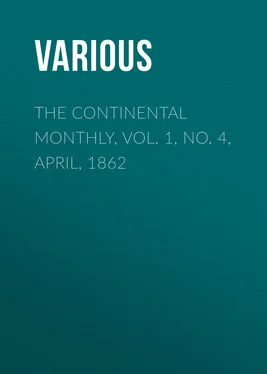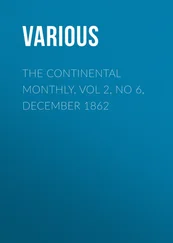Various - The Continental Monthly, Vol. 1, No. 4, April, 1862
Здесь есть возможность читать онлайн «Various - The Continental Monthly, Vol. 1, No. 4, April, 1862» — ознакомительный отрывок электронной книги совершенно бесплатно, а после прочтения отрывка купить полную версию. В некоторых случаях можно слушать аудио, скачать через торрент в формате fb2 и присутствует краткое содержание. Жанр: foreign_antique, periodic, Языкознание, Политика, foreign_edu, на английском языке. Описание произведения, (предисловие) а так же отзывы посетителей доступны на портале библиотеки ЛибКат.
- Название:The Continental Monthly, Vol. 1, No. 4, April, 1862
- Автор:
- Жанр:
- Год:неизвестен
- ISBN:нет данных
- Рейтинг книги:3 / 5. Голосов: 1
-
Избранное:Добавить в избранное
- Отзывы:
-
Ваша оценка:
- 60
- 1
- 2
- 3
- 4
- 5
The Continental Monthly, Vol. 1, No. 4, April, 1862: краткое содержание, описание и аннотация
Предлагаем к чтению аннотацию, описание, краткое содержание или предисловие (зависит от того, что написал сам автор книги «The Continental Monthly, Vol. 1, No. 4, April, 1862»). Если вы не нашли необходимую информацию о книге — напишите в комментариях, мы постараемся отыскать её.
The Continental Monthly, Vol. 1, No. 4, April, 1862 — читать онлайн ознакомительный отрывок
Ниже представлен текст книги, разбитый по страницам. Система сохранения места последней прочитанной страницы, позволяет с удобством читать онлайн бесплатно книгу «The Continental Monthly, Vol. 1, No. 4, April, 1862», без необходимости каждый раз заново искать на чём Вы остановились. Поставьте закладку, и сможете в любой момент перейти на страницу, на которой закончили чтение.
Интервал:
Закладка:
There are in Brittany vast lines of massy Druidic stones, piled sometimes for leagues in regular order, in such a manner as to represent colossal serpents. Those who will consult the French Dracontia will be astonished at the labor expended on these strange temples. Squier has shown that the earth-works of the West represent precisely the same symbol. Mexico and South America abound, like Europe and the East, in serpent emblems; they twine around the gods; they are gods themselves; they destroy as Typhon, and give life in the hands of Esculapius.
In the United States, as in Europe and in the East, there are found in steep places, by difficult paths, always near the banks of streams, narrow, much-worn passages in rocks, through which one person 10 10 An Inquiry laid by me it few years ago before the Historical Society of Pennsylvania elicited information as to several of these 'gates' in that State. I have not the work by me, but I believe that FALES DUNLAP, Esq., of New York, asserts on Rabbinical authority, in an appendix to Sod or the Mysteries , that the Hebrew word commonly translated as 'passover' should be rendered 'passing through.'
can barely squeeze, and which were evidently not intended for ordinary travel. The passing through these places was enjoined on religious votaries, as indicating respect for the great principle of regeneration. The peasants of Europe, here and there, at the present day, continue to pass through these rock or cave doors, 'for luck.' It was usual, after the transition, whether into a cave, where mysteries, feasts, and orgies were held, significant of 'the revival,' or merely through a narrow way,—to bathe in the invariably neighboring river; the serpent-river or water which drowns organic life, yet without which it dies.
In England, at a comparatively recent period, and even yet occasionally in Scandinavia, the peasantry plighted their troth by passing their hands through the hole in the 'Odin-stones,' and clasping them. Beads and wedding rings and 'fairy-stones,' or those found with holes in them, were all linked to the same faith which rendered sacred every resemblance to the 'passing through.' The graves of both North and South America contain abundant evidence of the sacredness in which the same objects were held. I have a singularly-shaped soapstone ornament, taken from an Indian grave, whose perforation indicates the 'fairy-stone.' The religious legends of Mexico and of Peru are too identical with many of the Old World to be passed over as coincidences; the gold images of Chiriqui, with their Baal bell-ringing figures, and serpent-girt, pot-bellied phallic idols, are too strikingly like those of Old Ireland and of the East not to suggest some far-away common origin. I have good authority for saying that almost every symbol, whether of cup or dove, serpent or horn, flower or new moon, boat or egg, common to Old World mythology, may be found set forth or preserved with the emphasis of religious emblems in the graves or ruined temples of ancient North America.
The mass of evidence which has been accumulated by scholars illustrative of a common origin of mythologies and a centralization of them around the serpent; or, as G.S. Faber will have it, the Ark; or, as some think, the heavenly bodies; or, as others claim, simply a worship of paternity and maternity,—is immense. Why they should claim separate precedence for symbols, all of which set forth the one great mystery how GOD 'weaves and works in action's storm,' is only explicable on the ground that 'every scholar likes to have his own private little pet hypothesis.' Enough, however, may be found to show that this stupendous nature-worship was held the world over,— possibly in the days of a single language,—in America as in ancient Italy, or around the sacred mountain-crags of India; in Lebanon as in Ireland, in the garden-lands of Assyria, and in the isles of the South.
Yet all this is as yet, for the truly scientific ethnologist, only half-fact, indefinite, belonging to the cloud-land of fable. The poet or the thinker, yearning for a new basis of art, may find in the immense mass of legends and symbols an identification between all the forms of nature in a vast harmony and mutual reflection of every beautiful object; but for the man of facts it is unformed, not arranged, useless. We know not the color of the race or races which piled the Western mounds; their languages are lost; they are vague mist-gods, living in a dimmer medium than that of mere tradition. So ends the first period of intercommunication between Asia—the probable birthplace of the old mythology—and America.
II. The Chinese Discoverers Of Mexico In The Fifth Century
But there is a second link, ere we come to the Norsemen, which is strong enough to merit the favorable consideration of the scientific man, for it rests on evidence worthy serious investigation. I refer to the fact that the Chinese-Annals, or Year Books,—which, according to good authority, have been well kept, and which are certainly prosaic and blue-bookish enough in their mass of dry details of embassies and expenditures to be highly credible,—testify that in the fifth century the Chinese learned the situation of the great peninsula Aliaska, which they named Tahan, or Great China. Beyond this, at the end of the fifth century,—be it observed that the advances in discovery correspond in time in the records,—they discovered a land which Deguignes long after identified with the north-west coast of America. With each discovery, the people of these new lands were compelled, or were represented at court as having been compelled, to send ambassadors wife tribute to the Central Realm, or China.
But there had been unofficial Chinese travelers in Western America, and even in Mexico itself, before this time. Those who have examined the history of that vast religious movement of Asia which, contemporary with Christianity, shook the hoary faiths of the East, while a higher and purer doctrine was overturning those of the West, are aware that it had many external points or forms in common with those of the later Roman church, which have long been a puzzle to the wise. To say nothing of mitres, tapers, violet robes, rosaries, bells, convents, auricular confession, and many other singular identities, the early Buddhist church distinguished itself by a truly catholic zeal for the making of converts, and, to effect this, sent its emissaries to Central Africa and Central Russia; from the Sclavonian frontier on the west to China, Japan, and the farthest Russian isles of the east. On they went; who shall say where they paused? We know that there are at this day in St. Petersburg certain books on black paper taken from a Buddhist temple found in a remote northern corner of Russia. It was much less of an undertaking, and much less singular, that Chinese priests should pass, by short voyages, from island to island, almost over the proposed Russian route for the Pacific telegraph to America. That they did so is explicitly stated in the Year Books, which contain details relative to Fusang , or Mexico, where it is said of the inhabitants that 'in earlier times these people lived not according to the laws of Buddha. But it happened in the second "year-naming" "Great Light" of Song (A.D. 458), that five beggar monks, from the kingdom Kipin, went to this land, extended over it the religion of Buddha, and with it his holy writings and images. They instructed the people in the principles of monastic life, and so changed their manners.'
But I am anticipating my subject. In another chapter I propose, on the authority of Professor Neumann, a learned Sinologist of Munich, to set forth the proofs that in the last year of the fifth century a Buddhist priest, bearing the cloister name of Hoei-schin, or Universal Compassion, returned from America, and gave for the first time an official account of the country which he had visited, which account was recorded, and now remains as a simple fact among the annual registers of the government.
Читать дальшеИнтервал:
Закладка:
Похожие книги на «The Continental Monthly, Vol. 1, No. 4, April, 1862»
Представляем Вашему вниманию похожие книги на «The Continental Monthly, Vol. 1, No. 4, April, 1862» списком для выбора. Мы отобрали схожую по названию и смыслу литературу в надежде предоставить читателям больше вариантов отыскать новые, интересные, ещё непрочитанные произведения.
Обсуждение, отзывы о книге «The Continental Monthly, Vol. 1, No. 4, April, 1862» и просто собственные мнения читателей. Оставьте ваши комментарии, напишите, что Вы думаете о произведении, его смысле или главных героях. Укажите что конкретно понравилось, а что нет, и почему Вы так считаете.












